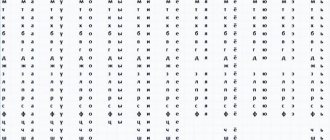All parents, without exception, wait for the moment when the child begins to say mom and dad. Many people think that children's speech begins to develop on the day the baby pronounces the first word. In fact, for this to happen, we need long-term preparation of the articulation organs, their coordinated work, the ability to switch, mobility of the lower jaw, lips, tongue, and soft palate. It is impossible to pronounce exactly those sounds that make up the first words if the child does not know how to distinguish them from phonemes that sound similar, for example, words such as cat-whale, slide-crust and others.
More precisely, human speech is formed during the prenatal period, when the organs of hearing, articulation and brain structures are formed. These processes are influenced by heredity, illnesses suffered by the mother, the presence or absence of bad habits, and the lifestyle of the baby’s parents. The course of labor and the state of health of the baby are important factors in his successful debut as a speaking and thinking person.
We will tell you at what age children begin to speak their first sounds, what this depends on, at what age children begin to speak in sentences, and how to help them go through each stage of speech development in a timely manner.
Speech in the first weeks and months of life
Immediately after birth, intensive development of brain structures begins, and new connections between neurons are established. At the same time, the organs of hearing and articulation develop, and physical and phonemic hearing is formed. Without proper hearing, children cannot master speech, since distortion or absence of sound signals entering the brain makes it impossible to develop speech skills.
In the first weeks and months of life, it is the speech of others that stimulates the initial stage of speech development. The baby listens to the speech of loved ones, he calms down for a while when he hears his mother’s voice, the impulsive movements of his arms and legs stop for a while. After some more time, he begins to turn his head towards the source of the sound.
Not all mothers and fathers talk to newborns and infants in the first months of life. They think this is unnecessary, because the baby doesn’t understand anything yet. Such one-sided “conversations” between parents and children, which accompany their bathing and waking, develop auditory concentration and the desire to respond. Attentive parents may notice how the child tries to move his lips, as if he wants to say something. It’s even better if parents often call the baby by name, show him toys, call the child, not moving much away from the crib.
This is the age at which a child begins to speak vowels and consonants. Up to 3 months, the child pronounces the following sounds:
- vowels – A, U, E;
- consonants – M, K, X, P, B, G.
These phonemes still sound unclear and are pronounced involuntarily. These skills mark the first stage of speech development – humming. In addition, the cry of a 1–3 month old baby is quite expressive. By intonation, the mother can determine whether the baby is bored, wants to eat, or it’s time to change wet diapers, that is, he has begun to master intonation.
WHAT IS THE FIRST WORD?
It is clear that after a few years speech will become much more perfect. The child will learn to pronounce all sounds, coordinate the parts of a sentence without errors, retell, analyze, and compose. But that very first word will forever remain in the memory of the parents. What could it be?
Most often these are onomatopoeias or distortions that characterize the beginning of autonomous speech, understandable only to the baby and his parents. So this is definitely not the word “mother”. Rather, something like “am-am”, “tsa-tsa” or “give-give”. But is this a word? In modern pediatrics, it is customary to call a word that “set of sounds” that is always used by the baby in the same meaning and is associated with the same objects or actions.
If the baby calls everything related to food (including the process of eating food) “am-am,” then this is the word. If “tsa-tsa” is everything that is beautiful or needed to bring beauty - this is the word. The most real thing. A stable lexical unit used by a child. If not, more babble. In this case, the first words usually consist of two repeated or different, but simple syllables. In this case, we can already assume that the child is starting to talk.
At what time the baby will say the first word is an individual question. Some people are already scribbling with all their might at the age of one, while others are not very talkative even at two.
From humming to babbling
At the beginning of the fourth month, the baby begins to look for an adult, smiles, and begins to intensively move his arms and legs (revitalization complex). He begins to emit drawn-out and melodious combinations of sounds - he cooes, saying a-a, a-gu, a-ha. Some sounds are simply impossible to reproduce; such phonemes do not exist in the Russian language.
After another 2–3 months, the turn of babbling comes. At first these are individual syllables pa, ka, na, ma, which a little later become similar to the peculiar words pa-pa-pa, ka-ka-ka, na-na-na. Most often, babbling appears when the baby is full, has slept and is in a good mood. This is not yet a speech, but preparation for it, a kind of preparatory exercise.
Although he does not speak yet, he understands a lot - he turns his head when he is shown a familiar toy, a bird, a cat. Children 6-7 months old fulfill simple requests - give a pen, play palms, and this is also a step towards speech development.
At what age does a child begin to understand?
All children are different. You can find many tables that describe what children can do at a given age. However, each child has his own individual parameters. Despite this, parents should definitely study the information on how the child’s age corresponds to his speech development:
- 1–3 months - the child screams, cries loudly, tries to repeat simple sounds - “a-a”, “a-gu”, “a-wu”.
- 4–5 months – the baby laughs, squeals, and makes drawn-out sounds with different intonations and emotions.
- 6 months - the baby recognizes the voices of his parents, tries to babble, makes sounds a little like “ma”, “pa”.
- 7–8 months – the child perceives words and simple requests (give, take). This is exactly the age when a child begins to understand the word “no” and imitates the bark of a dog or the sounds made by other animals. At 8 months, the baby remembers the names of some objects, but still cannot pronounce them.
- 9–11 months - the baby learns to speak simple words - “mom”, “dad”, “na”, “give”. His vocabulary contains no more than 10 words.
- 1–1.5 years – the child knows how to form word combinations, knows what some animals and people look like, and can identify them from illustrations.
- 2–3 years – children understand and learn to ask questions, know different concepts, carry out simple tasks, make sentences, learn and tell fairy tales and poems.
- 3–4 years old - the child already talks not only with mom and dad, but also with relatives and sometimes with unfamiliar children.
According to long-term statistics, the first word of most children is “mama” or “dai.”
How to stimulate babbling
From 6 months, children are able to move in space - sit and crawl. Their perception improves, they can repeat sounds after adults. This skill can be developed - as soon as the child pronounces the syllables, the parents repeat them after him. This technique develops hearing, articulation organs, speech exhalation, and encourages the baby to pronounce these syllables again and again. Such mini-lessons are carried out with a cheerful, well-fed and healthy baby. If he is cold, hungry, or unwell, verbal games with his parents will not do any good.
It’s good if the child sees the face of the one who is talking to him, then he will be able to repeat the movements of his mother or father’s lips. In order for sounds to be heard clearly, you need to ensure complete silence - turn off the music, mute the sound of the TV.
You can play “hide and seek” by covering the baby’s face with a diaper and saying “peek-a-boo.” Showing adults objects of the environment develops passive vocabulary well. In this case, you need to clearly name them, accompanied by a pointing gesture. Soon the child will find them with his eyes, reacting to the adult’s question “Where is the watch?”, “Where is the cat?”, “Where is the car?”
When do the first words and phrases appear?
It is impossible to name the exact date at which children begin to speak their first words. They can appear at 8–9 months and at 1 year 2 months. And all this is the norm. According to the observations of parents and teachers, girls usually start talking earlier than boys, although there are exceptions. At the turn between the first and second years, the baby’s vocabulary contains from 2 to 20 words. Usually this:
- simplified words (ma-ma, pa-pa, la-la, ki-sa, am-am);
- onomatopoeia (beep, peek-a-boo, peep-peep).
It is at this age that the child speaks to his mother. Why do children pronounce words in their native language? Because the adults around him single out from the baby’s babbling syllables and sound combinations that are inherent specifically in their language system, and repeat only them. Therefore, the period of babbling is important for the development of children's speech.
At one and a half years or a little later, the baby begins to combine words into sentences, as long as they consist of two words. The words in them are not consistent, an example of the following phrase: “Give me a doll” (give me a doll), “Papa is not there” (dad is not at home). But this is the age when attentive mothers notice that their baby begins to speak in sentences.
Speech development of a child 1-3 years old
| Child's age | Speech capabilities |
| 1 year | The baby knows and uses several babbling words, for example: “mom, dad, baba, am, aw...” The passive vocabulary is also expanded. The child already knows the names of objects used in everyday life, the names of some animals, and understands the names of all family members. |
| 1 year, 3 months | Active vocabulary increases to 30-40 words. Moreover, it is already possible to construct two-word sentences, for example: “lala buh”, “dad give”, “mama am”. |
| 1.5 years | 40-50 words, it’s easy for a child to repeat frequently repeated words after an adult, more phrases appear. |
| 1.5-2 years | The number of words and phrases is growing. The child is already able to express a lot in words. Children at this age can finish words and fragments of words when children’s rhymes, songs, and jokes are read by adults. |
| 2 years | Normal vocabulary reaches up to 200 words. Along with nouns, verbs, linking words, and adjectives appear. Three-word sentences appear. |
| 2 years, 3 months | The baby can actively talk and begins to use inflection and word formation. Spreads sentences, tries to add previously unused words to them |
| 2 years, 6 months | 200-300 words. The baby can speak in sentences and ask questions. Difficulties in sound pronunciation persist, hissing sounds (sh, g), whistling (s, z), sonorant sounds (r, l) are impaired. This is the absolute norm for this age. |
| 3 years | 1000-1500 words. The child’s speech is quite clear and understandable, sentences still include agrammatisms, but the baby can already reproduce rhymes, sing songs and is a full participant in family conversations. |
Of course, the examples given are highly averaged and perhaps reflect data from only a portion of children developing normally. Deviations in vocabulary for a couple of months do not carry any possible concerns. But it can be noted that a child of one and a half years should already be able to pronounce unstable simple phrases of two words. It is possible that the number of words in stock will not be the same as shown in the table. By the age of two, the baby can use onomatopoeia, but their number should also gradually increase.
How to stimulate the pronunciation of words at 1 year old
By the age of 1, speech is not yet the most important means of communication for children. It is necessary to teach the baby to use speech. To do this, you do not need to immediately give the toy that the baby wants to take. First you need to say the name of the toy (you can simplify it): “Should I give you a la-la?” Let the baby try to repeat “la-la”, “beep-beep”. When presenting the desired item, you can emphasize: “This is lala, na.”
The vocabulary of an adult communicating with a baby should contain both full and abbreviated words: “kar-kar”, “ding-ding”, “knock-knock”, “tick-tock”. These substitutes for full words are temporary and are needed only because they are easier for the child to pronounce.
In order for children to establish a connection between a word and an action, you need to ask him to perform some action: give or take a toy, show a familiar object, wave a hand. Also verbalize all the actions that he performs with toys. For the same purpose, they play with 2–4 familiar toys and ask the baby, for example, to take a ball, throw it or catch it. Adults carry out all actions emotionally, clearly pronouncing both words-objects and words-actions.
How to develop a child's speech at 1 year old
At one year of age, you can promote the child’s speech development with the help of special exercises. Every parent can conduct them. Developmental exercises are based on games, songs, reading poems and fairy tales.
Games for speech development
During any game, you need to pay attention to the signs and features of objects, and pronounce them out loud. You should choose games where you need to repeat words after an adult, sing a song, recite a rhyme, or complete a simple task.
- Drawing. The lesson is useful at any age, it trains hand motor skills, the development of thinking processes, memory, and attention. You can draw anything, the main thing is to tell children about the drawn object, what parts it consists of, what color is best to paint each element. During the game, you can tell funny rhymes, for example, when animals are depicted.
- Pyramid. 70% of children have the game, but not every parent plays it correctly with their child. Assembling the pyramid consists of several stages. First, the parent shows an example of collection, pronounces one feature of the object - color: “we put a red ring on a yellow one, a blue ring on an orange one, etc.” Then you need to invite the child to put the pyramid together. The next stage is putting the pyramid together, pronouncing not only the color, but also the shape, size of the object - round, rectangular, triangular or square, large, small, huge, medium.
- As the animals say. All children like this game about animals. It is important not just to pronounce animals and the peculiarities of their speech, but also to include cubes, drawings, and cards in the game so that the child can simultaneously find the desired animal or bird. The game is easy to use and is based on a dialogue with the baby: “What does the chicken say?” The kid answers: “Ko-ko.”
− “What does the goat say?”
− “Be-be.”
− “What does the frog say?”
− “Kwa-kwa.”
A 1 year old baby will not immediately pronounce all the syllables, it is important to help him. This is what learning to speak is all about.
Tips for active parents
The development of a baby’s speech directly depends on whether it develops spontaneously, or whether parents take direct part in its development. This determines at what age children begin to speak sounds/words/sentences. Positive conditions for the formation of children's speech:
- There is no need to force speech development with frequent exercises that are not appropriate for the baby’s age - there is a high risk of speech negativism, stuttering and nervous tics, since the capabilities of the child’s brain are not limitless.
- There is no need to lisp, faking your speech as a child’s speech, and often use diminutive suffixes - the only thing worse than this can be a complete disregard for communication.
- Delicately correct speech mistakes made by your child, never make him laugh, but show him an example of the correct pronunciation of a given speech utterance. For example, I see houses, yes, you see houses.
- Protect your baby from communicating with people with speech defects (burr, stutter), and especially with illiterate speaking adults (put down - lies, mouths - mouths, beautiful cat - beautiful cat), this “infects” and “invades” children’s speech so much that Such imitations are eradicated with great difficulty.
- When reading children's works, watching cartoons with your child, always explain unfamiliar words, the actions of the characters, and pay attention to vivid turns of speech.
It is very useful to record and listen to the baby’s speech every month - humming, babbling, first phrases, reading poetry. Such an archive will one day become an excellent gift for an older child and your grandchildren.
Today we answered the question of when should a child start speaking and at what months do the first sounds appear. If you suspect a delay in speech development in your baby, consult us. We will dispel anxiety, and if it is objective, we will tell you how to talk or simply teach your child to speak. We know more than a dozen examples of how parents sit and wait for their child to speak at 3, 4 and even 5 years old, although the development of big problems is already clearly visible. Ask us, we've been doing this all our lives!
Video on the topic
At what time do children begin to speak their first words? answer in video:
Thus, the child begins to pronounce his first words at about nine months of age. They are repeated syllables that the baby pronounces unconsciously. During this period, parents can hear “mom,” “baba,” and “dad.” Some children experience developmental delays.
They can be triggered by hearing impairment, lack of parental attention and other social, psychological, pathological and physiological reasons. In order for a child to start speaking faster, it is necessary to communicate with him more and conduct developmental activities.










